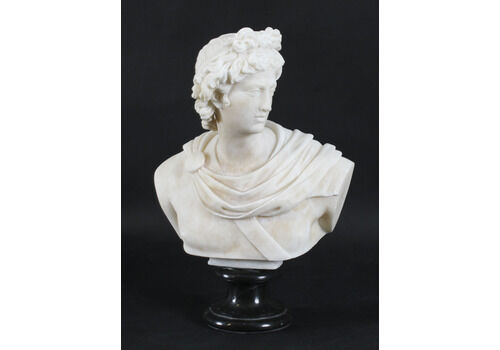Antique George III Wine Cooler By Matthew Boulton With Robinson Crest 18th C
£1,250 per item
Shopping at Vinterior
-
14-day return guarantee
-
Outstanding customer service
-
Secure payment
-
Buyer protection
-
Trees planted for every purchase

Item details
Height
28.0 cm
Width
27.0 cm
Depth
27.0 cm
Wear conditions
Excellent
Wear conditions
Excellent
Shows little to no signs of wear and tear.
Good
May show slight traces of use in keeping with age. Most vintage and antique items fit into this condition.
Average
Likely to show signs of some light scratching and ageing but still remains in a fair condition.
Apparent Wear and Tear
Visible signs of previous use including scratches, chips or stains.
Please refer to condition report, images or make a seller enquiry for additional information.
Description
This is an elegant antique English Old Sheffield plate silver on copper ice bucket or wine cooler, circa 1790 in date, and bearing the sunburst makers marks of the world renowned silversmith Matthew Boulton.
The cooler is of campana baluster form and has a pair of foliate cast scroll handles, gadrooned borders and flared rim.
It features an engraved Hamilton family crest with the motto
'Qualis ab Incepto' (The same from the beginning)
The Marital Arms of Robinson and Maltby
The armorial bearings as engraved upon this George III Old Sheffield Plate Wine Cooler by Matthew Boulton dating to circa 1790 are those of Robinson impaling Maltby. These armorial bearings denote the marshalling of a marital coat showing on the dexter (the heraldic right on the left as you view the piece) the arms of the husband and on the sinister (the heraldic left on the right as you view it) the arms of the wife.
These arms undoubtedly commemorate the marriage of William R2. Robinson (born circa 17933 died 11th December 18664), of 17 Hyde Park Terrace, Paddington in the County of Middlesex and of Austin Friars in the City of London and his first wife, Jane Maltby (baptised 29th May 17966 died 1833). They were married at the Parish Church of St Mary the Virgin, Walthamstow in the County of Essex on the 8th June 1819. William was the eldest son of William Tooke Robinson, of Water House, Walthamstow in the County of Essex and his wife, Isabella Straker, whilst Jane was the fourth daughter of Thomas Maltby, of Upper Harley Street in the County of Middlesex and of Walthamstow in the County of Essex and his wife, Henrietta Crichton.
See attached photos of the document and the house.
The attention to detail is absolutely fantastic and it is certain to attract attention wherever they are placed.
Condition:
In excellent condition with clear makers marks and no dings, dents or signs of repair. Please see photos for confirmation.
Dimensions in cm:
Height 28 x Width 27 x Depth 27
Dimensions in inches:
Height 11 inches x Width 11 inches x Depth 11 inches
Matthew Boulton
Boulton was not a "goldsmith" or a "silversmith" in the accepted sense, yet for his achievements and services to the craft of goldsmithing he is fully worthy of inclusion in the list of great English goldsmiths.
Matthew Boulton was born in Birmingham on 3 September 1728. His father Matthew Boulton (senior) was a "toy maker" and silver stamper specialized in the production of shoe-buckles.
Boulton junior was taken into partnership in 1749 and was left in sole charge of the business after the death of his father in 1759.
Boulton had the ambition to establish a manufacturing complex where craftsmen in the various branches of the "toy" trade would work together under one roof, enabling him to reap both wholesale and retail profits. In 1761 he realized his project purchasing a one-hundred- year-lease of the "Soho" estate at Handswoth Heath (two miles from Snow Hilton the Wolverhampton Road).
In 1762 Boulton took into unofficial partnership John Fothergill who would act as a travelling salesman to advertise his wares and the factory moved to Soho in the same year.
The partnership concentrated in the production of steel "toys" a little later on buttons and buckles made in a variety of substances, including , of course, silver. In 1762 Soho factory began to produce articles in "Sheffield" plate and one of the first to adopt "Sterling silver thread" edging which prevent to reveal the underlying copper.
Boulton soon became the largest manufacturer of "Sheffield plate" of the country expanding the business of Soho manufactory in the production of bijouterie, objects d'art and de virtue, in ormolu, pinchbeck and shell, and in clocks.
In 1765 Boulton began the manufacture of pieces in solid silver, being obliged to send every piece of plate to Chester to be marked (Chester was the nearest assay office, 72 miles away from Birmingham). Boulton was the promoter a petition obtaining in 1773 the Royal Assent to assay silver in Birmingham (the same was for Sheffield).
Boulton & Fothergill entered their joint mark consisting of their initials, MB before IF. After the death of Fothergill (1782) Boulton punched his plate with his initials alone.
When manufacturers of plated ware were permitted to register their marks at the Assay Office in Sheffield (1784), Boulton registered his mark of "twin suns" under the name Boulton M. & Co.
The most important designers for Boulton plate in the neo-classic taste were Robert Adams and James Wyatt.
Matthew Boulton died on 17 August 1809.
The mark MB continued to be used by Matthew Boulton Plate Co until 1832.
Old Sheffield Plate - or ‘fused plate' as it is sometimes known, was the first commercially viable method of plating metal. The material was accidentally invented by Thomas Boulsover, of Sheffield's Cutlers Company, in 1743. While trying to repair the handle of a customer's decorative knife, he heated it too much and the silver started to melt. When he examined the damaged handle, he noticed that the silver and copper had fused together very strongly. Experiments showed that the two metals behaved as one when he tried to reshape them, even though he could clearly see two different layers.
Boulsover set up in business, funded by Strelley Pegge of Beauchief, and carried out further experiments in which he put a thin sheet of silver on a thick ingot of copper and heated the two together to fuse them. When the composite block was hammered or rolled to make it thinner, the two metals were reduced in thickness at similar rates. Using this method, Boulsover was able to make sheets of metal which had a thin layer of silver on the top surface and a thick layer of copper underneath. When this new material was used to make buttons, they looked and behaved like silver buttons but were a fraction of the cost.
The technique Boulsover developed was to sandwich an ingot of copper between two plates of silver, tightly bind it with wire, heat it in a furnace and then mill it out in to sheet, from which objects could be made.
Cancellations
We offer free cancellations and full refund for orders cancelled before dispatching. View full policy.
Returns
We have a 14-day return guarantee for orders from individual sellers, within the UK and European Union. View full policy.
Free UK Mainland delivery.
Estimated delivery time
Less than one week
Free collection available
Yes
Choose a Wishlist
Create Wishlist
- Selling at Vinterior since 2016
- 304 sales
- Ships from London, United Kingdom
Seller Reviews

Verified Purchase


Verified Purchase


Verified Purchase

Cancellations and Returns
Last updated: 24th March 2025
We want everybody’s Vinterior experience to be seamless, so both buyers and sellers can fall in love with pre-loved. We designed our Terms of sale to treat everybody fairly.
However, sometimes things don’t go exactly to plan, and you may need to cancel or return an order.
To prevent this, we encourage you to check listings, photos and descriptions carefully before you buy. If you aren’t sure about a piece’s condition, size, provenance or shipping, just ask; click Contact seller to get in touch. Always contact your seller first if you have any queries, at any point in your purchase.
Our buyers receive the same protection when buying from all our sellers, both professional and verified.
Can I cancel an order?
There are many reasons why you might need to cancel an order, and you'll often be entitled to a refund. To cancel an order, click Create cancellation on the order page.
If you cancel your order before it has been dispatched, you will receive a full refund - including delivery costs. However, if your item has been shipped, delivery costs will not be included in your refund.
Please note: orders of bespoke, personalised or made-to-order pieces cannot be cancelled.
Can I return an order?
We understand that sometimes a piece isn’t the perfect fit. So if you no longer want your order, our returns process will ensure it finds a new home fast.
The Vinterior Guarantee included with your purchase entitles you to 14-day returns - allowing you to return any item within 14 days of the delivery date (except in specific circumstances, detailed below).
You can return your order if...
It isn't what you expected
If what arrives isn’t what you ordered, you can open a return. Just send us some photo evidence that the listing was inaccurate, misleading or misrepresented your purchased piece, and you’ll receive a refund.
You change your mind
If you don’t feel a piece is right for your space, you can return it. Once you request a change of mind return, you’ll be responsible for shipping the piece back to your seller as soon as possible. Delivery costs are non-refundable.
It's damaged in transit
In the rare event that an item arrives damaged or defective, you have a full 30 days from the date of delivery to return it for a full refund.
If your purchase arrives broken, always let us know. If Proovia delivered the piece, we can raise an insurance claim on the seller’s behalf. Or, the seller can raise a claim with their chosen courier.
What can't I return?
Just as there are some orders you can’t cancel, there are some you cant return, too. Personalised, bespoke or made-to-order pieces are non-returnable, and non-refundable. Sellers may also reject your return if the item has been altered in any way.
Please note: pieces on our site are pre-loved, not new. They may show some wear and tear; this is not sufficient grounds for a refund, unless the seller has misrepresented the item’s condition.
Lastly, neither Vinterior nor our sellers are liable for any damages or loss sustained in transit via third parties.
I'm eligible for a return. Now what?
To initiate a return, log into your Vinterior account, then go to the relevant order page and click Create a return. In the return request, be sure to include all the details: the reason for your return, an in-depth description, and photos of any issues or damage.
How will I receive my refund?
Once the seller confirms they’ve received the item (in the same condition it was sent), we will send your refund to your original payment method.
All items are inspected on return. If the seller receives the return with damage they don’t recognise, we will not be able to process your refund and the seller may need to send the piece back to you. You will be required to cover these delivery costs.








